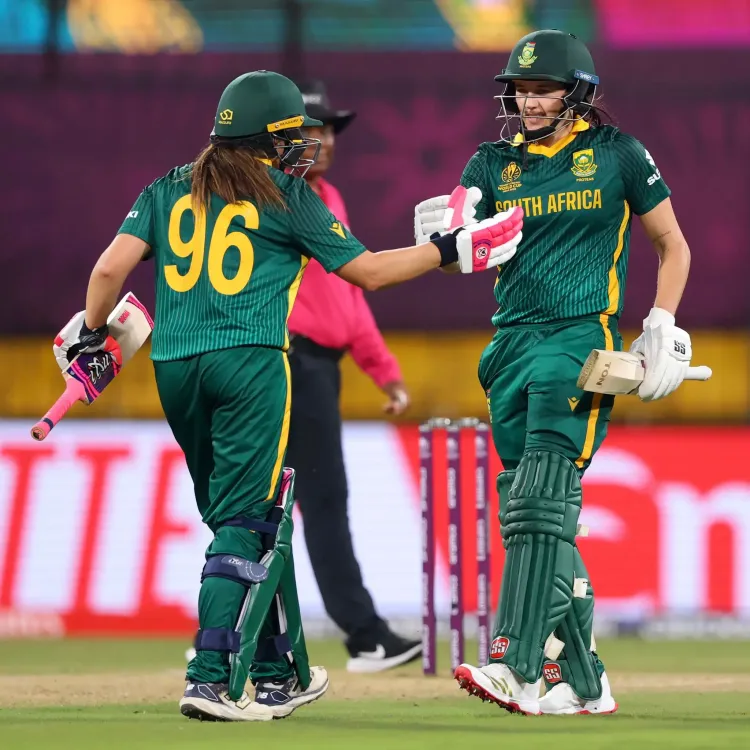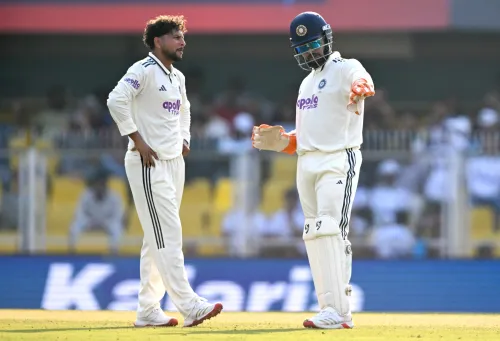How Did Tazmin Brits' Century and Luus’ Brilliance Lead South Africa to Victory?

Synopsis
Key Takeaways
- Tazmin Brits scored a century, leading South Africa to victory.
- Sune Luus remained unbeaten, contributing significantly to the chase.
- South Africa set a new record for the highest World Cup partnership.
- Nonkululeko Mlaba took four wickets to restrict New Zealand.
- South Africa's growth in women’s cricket is evident through their performance.
Indore, Oct 6 (NationPress) Tazmin Brits delivered an outstanding performance with a remarkable score of 101, complemented by an unbeaten 83 from Sune Luus, propelling South Africa to a decisive six-wicket win against New Zealand during their Women’s World Cup match at the Holkar Stadium on Monday.
While chasing a target of 232, the Proteas enjoyed a strong start as openers Brits and Laura Wolvaardt maintained a brisk scoring pace early in the innings.
Both Brits and Wolvaardt struck three boundaries within the first two overs of the powerplay, establishing a solid foundation for their chase. The Proteas captain further hammered two more boundaries before being dismissed by Jess Kerr for 14.
Sune Luus joined Brits at the crease and seamlessly continued the momentum, ensuring the match slipped away from New Zealand. After a brief period of caution, Luus and Brits consistently found the boundary, keeping the run rate above five throughout their innings.
By the end of the powerplay, South Africa stood at 54/1. Brits targeted Sophie Devine, scoring two fours in the 11th over, keeping the pressure on the White Ferns.
In the 13th over, Luus joined the boundary-hitting spree, hitting the first six of the match off Amelia Kerr. The New Zealand bowlers struggled to rein in the scoring as boundaries flowed from both ends.
The Proteas hit the three-figure mark in the 17th over, with both batters smoothly reaching their half-centuries. Brits was first to her fifty, striking a four towards long-on in the 19th over. After reaching her half-century, she accelerated, forming their fifth century partnership in ODIs for 2025—the most by a South African duo within a calendar year.
They also set a new record for the highest World Cup partnership for any wicket for South Africa, surpassing the 128-run stand between Marizanne Kapp and Dane van Niekerk for the sixth wicket against Pakistan in Cuttack in 2013.
Meanwhile, Luus too raced to her half-century as South Africa reached 159/1 after 26 overs. The run flow remained steady as South Africa marched towards a commanding victory, though a run-out appeal by the wicketkeeper briefly raised tensions in the Proteas' camp. However, the replay confirmed that Brits had safely returned to the crease before Isabella Gaze removed the bails.
The pair built a substantial 150-run stand before Brits celebrated her fifth ODI century of the year, setting a record for the most centuries in a calendar year, surpassing Smriti Mandhana’s four tons in the ongoing year. Brits also achieved this feat in the fewest (41) innings to reach seven ODI centuries.
Shortly after reaching three figures, Brits was dismissed by Lea Tahuhu, offering a brief respite to the Kiwi camp. Her stellar innings totaled 101 runs off 89 balls, featuring 15 fours and a six.
New Zealand attempted to stage a comeback, taking out Marizanne Kapp (14) and Anneke Bosch (0) cheaply; however, there weren't enough runs left to defend as Luus and Sinalo Jafta remained unbeaten on 83 and 6, respectively, leading South Africa to chase the target with 55 balls to spare.
For New Zealand, Amelia Kerr took two wickets, while Jess Kerr and Lea Tahuhu claimed one wicket each.
Earlier, left-arm spinner Nonkululeko Mlaba shone with a four-wicket haul, helping South Africa bowl out New Zealand for 231, despite a valiant 85 from Sophie Devine.
Choosing to bat first, the Kiwis experienced a disastrous start, losing veteran opener Suzie Bates for a duck on the very first ball of her 350th international game for New Zealand. She was trapped lbw by Proteas pacer Marizanne Kapp, putting the White Ferns under immediate pressure. This marked Bates' second consecutive duck in the tournament after a similar failure against Australia at the same venue.
Nevertheless, Georgia Plimmer and Amelia Kerr orchestrated a comeback, forming a crucial 44-run partnership for the second wicket. Following the early setback, the duo took a cautious approach, bringing the score to 38/1 by the end of the powerplay.
The partnership was broken by Nadine de Klerk in the 13th over, dismissing Amelia Kerr for 23. Sophie Devine then joined Plimmer, and they engaged in another vital stand as South Africa kept them from scoring freely despite the end of the powerplay.
Devine and Plimmer added 57 runs for the third wicket, with Devine contributing more than half. Chloe Tryon claimed the third wicket for the Proteas when Plimmer handed a simple catch to Nadine de Klerk at long-on, reducing New Zealand to 101/3 after 25.4 overs.
The arrival of Brooke Halliday at the crease boosted the scoring rate for New Zealand, with Devine supporting from the other end. Halliday played aggressively, scoring boundaries at regular intervals.
During this time, Devine reached her 17th ODI half-century, maintaining a stronghold as the Kiwis crossed the 150-run threshold. Nonkululeko Mlaba ended the 86-run partnership by dismissing Halliday in the 39th over; Halliday contributed a rapid 45 runs off 37 balls, including six fours.
New Zealand faltered after that, losing Maddy Green (4) and Isabella Gaze (10) quickly, before Mlaba bowled out Devine for 85 in the 45th over, concluding New Zealand's innings decisively. Devine’s knock was decorated with nine fours and came at a crucial time, coinciding with her 300th international game.
Mlaba concluded her spell with figures of 4-40 in her 10 overs, successfully bundling New Zealand out for 231/10 in 47.5 overs.
Brief Scores: New Zealand 231/10 in 47.5 overs (Sophie Devine 85, Brooke Halliday 45; Nonkululeko Mlaba 4-40) lost to South Africa 234/4 in 40.5 overs (Tazmin Brits 101, Sune Luus 83 not out; Amelia Kerr 2-62) by six wickets.









